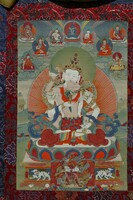Vajrasattva Main Page - Updated

Vajrasattva is a Buddhist deity originating in India and primarily functioning universally as a Tantric practice for the purification of sins and defilements. Vajrasattva also has a number of forms used as meditational deities (ishtadevata, yidam).
Vajrasattva is the inner form of the primodial buddha Vajradhara and represents all the Buddha Families. The 'Solitary Universal Ruler,' in the single aspect without consort, arises from the Yoga Tantras. In the New (Sarma) Schools of Tibetan Buddhism Vajrasattva with consort arises from the class of Anuttarayoga Tantra, specifically from the Abhidhanottara Tantra, 25th chapter, and is known as Heruka Vajrasattva.
In the Nyingma Tradition Vajrasattva is not only a deity of purification but an important meditational deity with many Kama (Oral) and Terma (Treasure) traditions. The most famous meditational form is the Vajrasattva of the Mindroling Monastery Tradition commonly known as the Min-ling Dor-sem.
Depictions of Vajrasattva in sculpture and painting are often confused with the similar deities - Vajradhara, Vajrapani, Vajravidarana, the Five Symbolic Buddhas (in Sambhogakaya form), and others. In a number of Yoga Tantra examples the form of Vajrapani, in the Sarvadurgati Parishodhana Tantra system, appears in exactly the same appearance as the typical 'Solitary Hero' Vajrasattva. A sculpture of the primordial Buddha Vajradhara has the exact same physical iconographic appearance as Heruka Vajrasattva - also depicted with the two hands holding a vajra and bell crossed in embrace holding the consort. In paintings the Heruka Vajrasattva is painted white while the Vajradhara form always appears blue in colour. In physical appearance many forms of Vajrasattva and Vajravidarana are only recognized and differentiated because Vajrasattva holds a single vajra scepter to the heart while Vajravidarana holds a double vajra scepter to the heart. Vajravidarana, like Vajrasattva, can also appear in a white form.
Vajrasattva Forms:
1. Solitary Hero in bodhisattva posture, from the Yoga Tantras
2. Solitary Hero in vajra posture
3. Vajrasattva, Yellow (Atisha Tradition)
4. Vajrasattva with Consort, Anuttarayoga Tantra
5. Heruka Vajrasattva, hands crossed at the heart
6. Vajrasattva 17 Deity Mandala (Mitra Gyatsa)
7. Vajrasattva (Mindroling Tradition)
8. Samputa Vajrasattva, Samputa Tantra
9. Vajrasattva Samvara 17 Deity Mandala
